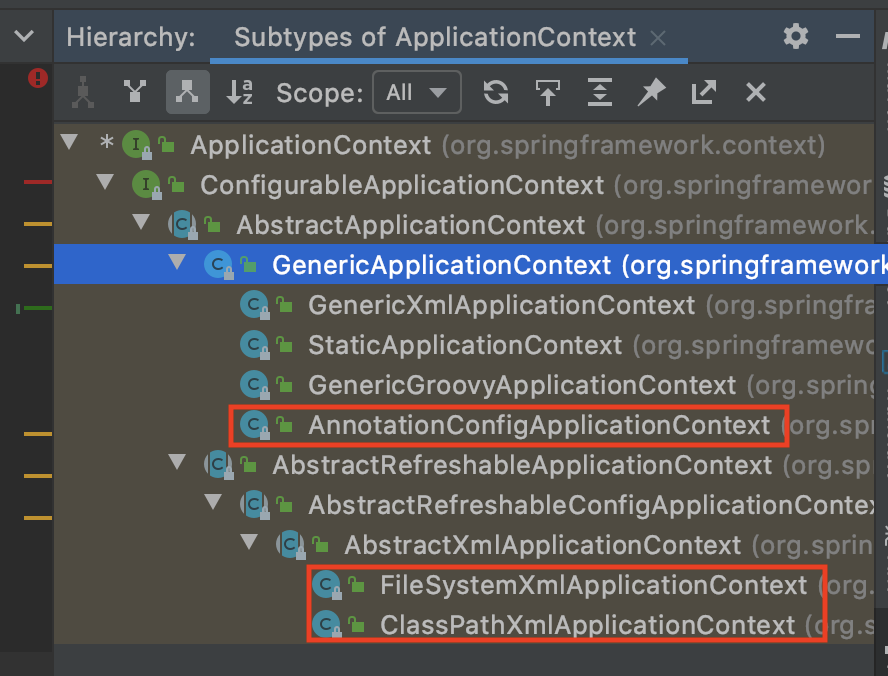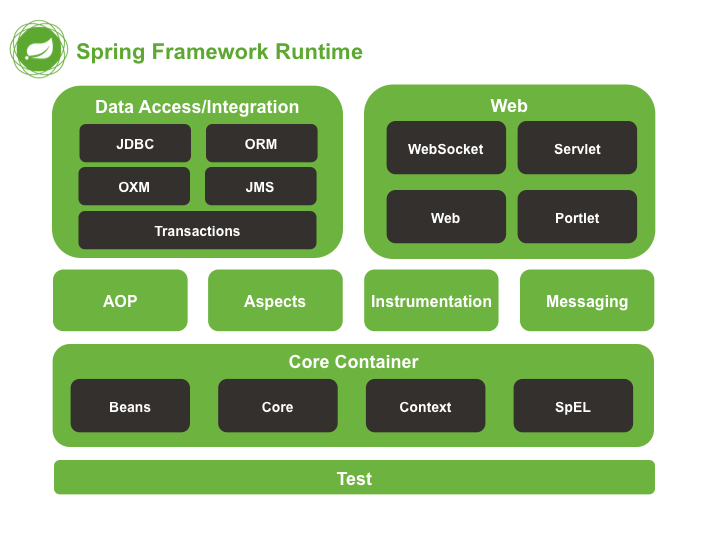说明
- 分析vue作为一个MVVM框架的基本实现原理
- 数据代理
- 模板解析
- 数据绑定
- 不直接看vue.js的源码
- 剖析github上网友模仿vue实现的mvvm库,地址:https://github.com/DMQ/mvvm
netcat是网络工具中的瑞士军刀
AOP:全称是Aspect Oriented Programming 即:面向切面编程。通过预编译方式和运行期动态代理实现程序功能的统一维护的一种技术。AOP是OOP的延续,是软件开发中的一个热点,也是Spring框架中的一个重要内容,是函数式编程的一种衍生范型,利用AOP可以对业务逻辑的各个部分进行隔离,从而使得业务逻辑各部分之间的耦合度降低,提高程序的可重用行,同时提高了开发的效率。
说明:Spring中的AOP就是通过配置的方式实现动态代理功能。
1.在pom.xml中导入相应jar包
1 | <dependencies> |
2、在resources目录下创建bean.xml配置文件,并指定Spring在创建容器时要扫描的包,及将项目中依赖的外部jar包中的类及其依赖注入
1 | <?xml version="1.0" encoding="UTF-8"?> |
3、在对应的类或方法上标记相应的注解
完全去除XML文件需要用到的其他注解
<context:component-scan base-package="io.github.lonelyMrZhang"></context:component-scan>在注解+XML的项目基础上,进行以下操作:
1.删除resources下的bean.xml类,并创建jdbcConfig.properties数据库配置文件
1 | jdbc.driver=com.mysql.jdbc.Driver |
properties文件中的数据可以使用@Value注解通过EL表达式取出
1 | @Value("${jdbc.driver}") |
2.创建config包下创建SpringConfiguration配置类,并标注@Configuration注解告诉Spring容器这是一个配置类、标注@ComponentScan(“io.github.lonelyMrZhang”)注解告诉Spring创建容器时要扫描的包、标注@PropertySource(“classpath:jdbcConfig.properties”)注解加载properties配置文件,如果还有其他配置类可以使用@Import(JdbcConfiguration.class)注解包含进来,不过要在该类上标注@Configuration注解。
1 | package config; |
1.在pom.xml中引入相应jar包
1 | <dependencies> |
2.在resources目录下创建bean.xml配置文件,并注入service、dao中相应类的依赖。
1 | <?xml version="1.0" encoding="UTF-8"?> |
注意<property>标签是基于set方法进行注入的,所以在.java文件中必须要有相应的set方法。
基于xml标签的配置:
1 | <bean id="accountService" class="io.github.lonelyMrZhang.service.impl.AccountServiceImpl" |
1 | <beans xmlns="http://www.springframework.org/schema/beans" |
1 | <context:component-scan base-package="io.github.lonelyMrZhang"></context:component-scan> |
<bean>标签实现的功能是一样的<property>标签的作用是一样的使用默认构造函数:在Spring的配置文件中使用bean标签,配以id和class属性后且没有其他属性和标签时,采用的就是默认的构造函数创建bean对象,此时如果类中没有默认构造函数,则对象无法创建。
1 | <bean id="accountService" class="io.github.lonelyMrZhang.service.impl.AccountServiceImpl"></bean> |
使用工厂类中的方法创建对象,并存入Spring容器。
1 | <!-- 1、先创建工厂类--> |
使用工厂中的静态方法创建对象,并存入Spring容器中。
1 | <bean id="accountService" class="io.github.lonelyMrZhang.factory.StaticFactory" factory-method="getAccountService"></bean> |
Spring Bean的作用范围可以通过bean标签的scope属性进行调节:
单例对象:
多例对象:
IOC的作用:降低程序间的依赖关系(耦合)
依赖关系的管理:以后都交给Spring来维护在当前类需要用到其他类的对象,由Spring为我们提供,我们只需要在配置文件中说明依赖关系的维护。
依赖注入:依赖关系的维护,就称之为依赖注入。
使用的标签:constructor-arg
标签出现的位置:bean标签的内部
标签中的属性:
优势:
弊端:
1 | <bean id="accountService" class="io.github.lonelyMrZhang.service.impl.AccountServiceImpl"> |
涉及的标签:property
出现的位置:bean标签内部
标签的属性:
优势:
弊端:
1 | <bean id="accountService2" class="io.github.lonelyMrZhang.service.impl.AccountServiceImpl2"> |
结构相同,标签可以互换
1 | <bean id="accountService3" class="io.github.lonelyMrZhang.service.impl.AccountServiceImpl3"> |
Spring中基于XML的IOC环境搭建
1 | <dependencies> |
2.在resources目录下创建配置文件bean.xml(名称可改变)
3.导入约束 在Spring源码中的 spring-framework-5.0.2.RELEASE/docs/spring-framework-reference/index.html中点击core,然后搜索xmlns,将搜到的约束拷贝。
1 | <?xml version="1.0" encoding="UTF-8"?> |
4、将对象的创建交给Spring管理,在bean.xml中添加如下<bean>标签
1 | <bean id="accountService" class="io.github.lonelyMrZhang.service.impl.AccountServiceImpl"></bean> |
5、获取Spring的IOC核心容器,并根据id获取对象
1 | package io.github.lonelyMrZhang.ui; |
IDEA中光标停留在要查看的类上 按下ctrl + h便可查看该类的所有实现类:

懒汉模式
通过BeanFactory构建Spring容器时,采用延迟加载的策略创建对象,即:什么时候根据id获取对象,什么时候真正的创建对象。适用多例模式
饿汉模式
通过ApplicationContext构建Spring核心容器时,采用立即加载的策略创建对象,即:只要一读取完配置文件马上就要创建配置文件中配置的对象。适用单例模式
Spring是什么?
Spring是分层的 java SE/EE应用 全栈轻量级开源框架,以IOC(控制反转)和AOP(切面编程)为内核,提供了展现层Spring MVC 和持久层Spring JDBC以及业务层事务管理等众多的企业级应用技术,还能整合开源世界众多著名的第三方框架和类库,逐渐成为使用最多的java EE企业应用开源框架。Spring官网
Spring优势
通过Spring提供的IOC容器,可以将对象间的依赖关系交由Spring进行控制,避免硬编码所造成的过度程序耦合。用户也不必再为单例模式类、属性文件解析等很底层的需求编写代码,可以更专注于上层的应用开发。
通过Spring的AOP功能,方便进行面向切面编程,许多不容易用传统OOP实现的功能可以通过AOP轻松应对。
可以将我们从单调烦闷的事务管理代码中解脱出来,通过声明式方式灵活的进行事务管理,提高开发效率和质量。
可以用非容器依赖的编程方式进行几乎所有的测试工作,测试不再是昂贵的操作,而是随手可做的事情。
Spring可以降低各种框架的使用难度,提供了对各种优秀框架的直接支持。
Spring对JavaEE API(JDBC、JavaMail、远程调用等)进行了封装,使这些API的使用难度大大降低。
Spring的源码设计精妙、结构清晰、匠心独用、处处体现着大师对java设计模式灵活运用以及对java技术的高深造诣,它的源码无疑是java技术的最佳实践的范例。
Spring体系结构

曾经项目中的问题
1 | package io.github.lonelyMrZhang; |
JdbcDemo1类依赖com.mysql.jdbc.Driver()类,如果没有Driver的jar包,代码在编译时将会报错。
将第一步注册驱动改为下面通过反射的方式注册便可降低耦合
Class.forName("com.mysql.jdbc.Driver");
总结:
1、使用反射来创建对象,避免使用new关键字
2、通过读取配置文件来获取要创建的对象的全限定类名
工厂模式解藕
分析:要解藕的创建对象需要以下两步:
1、需要一个配置文件来配置我们的service和dao,配置文件的内容:唯一标识ID=全限定类名(KV健值对)
2、通过读取配置文件中配置,反射创建对象
在代码中创建BeanFactory类:
1 | package io.github.lonelyMrZhang.factory; |
在需要创建对象的地方通过BeanFactory工厂创建,如下所示:
1 | // IAccountService accountService = new AccountServiceImpl(); |
通过以上方式就可降低代码间的耦合程度,当AccountServiceImpl实现类不存在时,只会产生运行时异常,而不会在编译器就出错。
上述方案的Bean工厂获取对象时每次都会创建一个新的实例,而在我们平时的开发过程中,service、dao对象都为单例模式模式,所以我们可以将BeanFactory设计为单例模式从而进一步优化。见链接代码。
IOC(控制反转)把创建对象的权利交给框架,是框架的重要特征,包括依赖注入(DI)和依赖查找(Dependency Lookup),IOC的作用就是削减程序中的耦合。